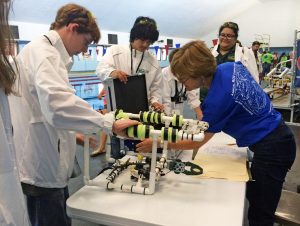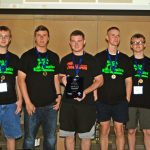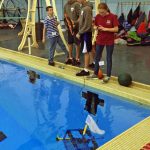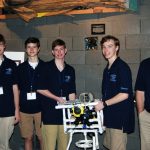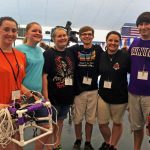Scientists Put ROV Technology in Hands of Teachers and Students
– July 23, 2015
As science, technology, engineering, and math (STEM) skills become increasingly important to the 21st century workforce, what better way to foster those skills in middle and high school students than an old-fashioned friendly competition?
Over the past four years, Deep-C and the Dauphin Island Sea Lab (DISL) have trained fifty-five teachers in summer workshops and have had over two-hundred students participate in spring competitions, advancing STEM education with remotely operated vehicles (ROVs).
Last July, sixteen middle and high school Gulf Coast teachers attended the five-day workshop “Technology in Marine Science,” where they learned how researchers use ROVs to investigate deep or dangerous waters. The course provided teachers with ROV technology training and tools to use in their classrooms and engage students’ interest in ocean sciences. That fall, the teachers used their new supplies and fresh knowledge about ROV design, construction, and operation to help students design and build their own ROV for the spring competition.
Student teams from twelve schools spent the 2014-2015 school year designing, building, and testing their ROVs in anticipation of the 3rd Annual Spring ROV Competition. The event served as the Marine Advanced Technology Education (MATE) Program Northern Gulf Coast regional competition. Teams used their ROVs to complete missions based on GoMRI research that reflected ROV use in marine exploration of deep ocean environments. Students gave oral and poster presentations – judged by local engineers and scientists – explaining their design and operation details. Scientist Will Patterson added additional educational components to the event with a student boat trip and lecture on how ROVs are used in research.
The event featured three levels of competition – Scout (entry-level), Navigator (mid-level), and Ranger (advanced-level). Ranger level winners attended this year’s international MATE competition in St. John’s, Newfoundland, Canada. Dr. Tina Miller-Way, a Deep-C Education Team member leading the DISL ROV program said, “It was great being able to offer all three levels of competition this year and allow the younger students to see how their ROVs and their understanding can grow more complex each year.”
The competing teams were:
- Chickasaw High School, Chickasaw, AL
- Evangel Classical Christian School, Alabaster, AL
- Scotlandville Middle School, Baton Rouge, LA
- Santa Rosa High School, Milton, FL – Ranger, 1st place
- James Clemens High School, Madison, AL – Navigator, 1st place
- James S. Rickards High School, Tallahassee, FL – Navigator, 2nd place
- Donnie Bickham Middle School, Shreveport, LA – Navigator, 3rd place
- Sacred Heart Cathedral School, Pensacola, FL – Scout, 1st place
- Fairview High School, Cullman, AL – Scout, 2nd place
- Hancock High School, Kiln, MS – Scout, 3rd place
- Jinks Middle School, Panama City, FL – Tethered Together Award (for great teamwork)
- Walker High School, Walker, LA – Buoyancy Award (for rising to the surface after problems)
For more information about the annual ROV competition, see the Deep-C ROV competitions webpage and fact sheet.
To learn more about Deep-C research and past ROV competitions:
- Deep-C at Sea: Disciplines Converge to Improve Response to Gulf Contaminants
- Deep-C Technology Experiences Bring Science to Life for Students (2013 Competition)
- Educators Dive into ROV Training and Emerge with Innovative Teaching Tools (2013 Workshop)
- (Click to enlarge)
- (Click to enlarge)
- (Click to enlarge)
- (Click to enlarge)
************
This research was made possible in part by a grant from the Gulf of Mexico Research Initiative (GoMRI) to the Deepsea to Coast Connectivity in the Eastern Gulf of Mexico (DEEP-C) consortium.
The Gulf of Mexico Research Initiative (GoMRI) is a 10-year independent research program established to study the effect, and the potential associated impact, of hydrocarbon releases on the environment and public health, as well as to develop improved spill mitigation, oil detection, characterization and remediation technologies. An independent and academic 20-member Research Board makes the funding and research direction decisions to ensure the intellectual quality, effectiveness and academic independence of the GoMRI research. All research data, findings and publications will be made publicly available. The program was established through a $500 million financial commitment from BP. For more information, visit https://gulfresearchinitiative.org/.
© Copyright 2010- 2017 Gulf of Mexico Research Initiative (GoMRI) – All Rights Reserved. Redistribution is encouraged with acknowledgement to the Gulf of Mexico Research Initiative (GoMRI). Please credit images and/or videos as done in each article. Questions? Contact web-content editor Nilde “Maggie” Dannreuther, Northern Gulf Institute, Mississippi State University (maggied@ngi.msstate.edu).

